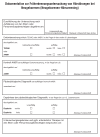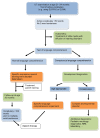Hearing impairment and language delay in infants: Diagnostics and genetics
- PMID: 25587365
- PMCID: PMC4273166
- DOI: 10.3205/cto000108
Hearing impairment and language delay in infants: Diagnostics and genetics
Abstract
This overview study provides information on important phoniatric and audiological aspects of early childhood hearing and language development with the aim of presenting diagnostic and therapeutic approaches. The article first addresses the universal newborn hearing screening that has been implemented in Germany for all infants since January 2009. The process of newborn hearing screening from the maternity ward to confirmation diagnostics is presented in accordance with a decision by the Federal Joint Committee (G-BA). The second topic is pediatric audiology diagnostics. Following confirmation of a permanent early childhood hearing disorder, the search for the cause plays an important role. Hereditary hearing disorders and intrauterine cytomegalovirus (CMV) infection, probably the most common cause of an acquired hearing disorder, are discussed and compared with the most common temporary hearing disorder, otitis media with effusion, which in some cases is severe enough to be relevant for hearing and language development and therefore requires treatment. The third topic covered in this article is speech and language development in the first 3 years of life, which is known today to be crucial for later language development and learning to read and write. There is a short overview and introduction to modern terminology, followed by the abnormalities and diagnostics of early speech and language development. Only some aspects of early hearing and language development are addressed here. Important areas such as the indication for a cochlear implant in the first year of life or because of unilateral deafness are not included due to their complexity.
Keywords: genetic hearing disorders; newborn hearing screening; organization of newborn hearing screening in Germany; pediatric audiology diagnosis; speech and language delay.
Figures
















References
-
- Smith RJH, Shearer AE, Hildebrand MS, et al. Deafness and Hereditary Hearing Loss Overview. In: Pagon RA, Adam MP, Ardinger HH, et al., editors. GeneReviews® [Internet] Seattle (WA): University of Washington; 1999 Feb 14 [Updated 2014 Jan 9]. Available from: http://www.ncbi.nlm.nih.gov/books/NBK1434/
-
- Morton CC, Nance WE. Newborn hearing screening--a silent revolution. N Engl J Med. 2006 May;354(20):2151–2164. doi: 10.1056/NEJMra050700. Available from: http://dx.doi.org/10.1056/NEJMra050700. - DOI - DOI - PubMed
-
- Kral A, O'Donoghue GM. Profound deafness in childhood. N Engl J Med. 2010 Oct;363(15):1438–1450. doi: 10.1056/NEJMra0911225. Available from: http://dx.doi.org/10.1056/NEJMra0911225. - DOI - DOI - PubMed
-
- Finckh-Krämer U, Spormann-Lagodzinski M, Gross M. German registry for hearing loss in children: results after 4 years. Int J Pediatr Otorhinolaryngol. 2000 Dec;56(2):113–127. doi: 10.1016/S0165-5876(00)00401-8. Available from: http://dx.doi.org/10.1016/S0165-5876(00)00401-8. - DOI - DOI - PubMed
-
- Böttcher P, Gramss M, Euler HA, Neumann K. Kostenanalyse des universellen Neugeborenen-Hörscreenings für Kliniken am Beispiel Hessens. [Cost analysis of a universal newborn hearing screening for clinics using the State of Hesse as an example]. HNO. 2009 Jan;57(1):21–28. doi: 10.1007/s00106-008-1879-7. (Ger). Available from: http://dx.doi.org/10.1007/s00106-008-1879-7. - DOI - DOI - PubMed
Publication types
LinkOut - more resources
Full Text Sources

